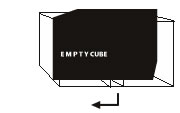CARLOS BUNGA
OCTOBER, 14, 2009

EXHIBITION INFORMATION
EMPTY CUBE PROJECT
2009
Performance
Project vs. Performance
Relationship with a space and its immediate surroundings has been one of the main features of Carlos Bunga’s oeuvre. This artist weaves a web of connections between the specificities of the architecture he encounters: his projects take as their starting-point a built context that is then subjected to a transformation. In some cases, his work also focuses on historical elements connected to these places, as a means of recovering memories and relational networks from different temporal sections.
Instead of adding to the original, perennial construction a fragile and ephemeral second structure, Bunga chooses to rewrite the original space, turning it into a kind of subtext on which he inscribes his faktura and emotional experience. This strategy demands an approach that intensifies the feeling of temporal compression present in the traces of pre-existing space and in the installation he builds. This act of superimposing a temporary and ephemeral construction – as the very quality of its materials attests – over something stable and permanent creates a boundary zone between the previous space and the work built by the artist, which re-interprets that spatiality as both an archetype and an evidence of the memory of the place.
This process includes a phase in which the work appropriates the original space as data from experience, which is then transferred onto the plane of representation. This need to take possession of space aims not at morphologically or functionally changing it; rather, it tends to deceptively reveal the transitoriness and impermanence intrinsic to all human actions. This notion of permanent change is closely connected to the performativity that impregnates all works by this artist and to the relationship with the documenting and recording of actions and performances he activates and takes part in, while also taking in the viewer (the audience) as a participating element. The videos, photographs and slides he displays in some of his projects constitute a residual archive of that transforming capacity.
Carlos Bunga’s project for EMPTY CUBE concentrates and synthesises three distinctive vectors of his work. First: EMPTY CUBE Project (2009) is a performative action in which he appropriates a built space that has been used to host several artistic projects. Second: Bunga carries out an action (which he himself describes as a performance) that is recurrent in his work – to deconstruct a space until it loses its form and functionality. Third: the artist concludes this action by taking pictures of it, thus carrying it to the plane of recording and memory.
The project/performance displayed at EMPTY CUBE can be viewed as a dividing moment in his work. The space being subjected to the performative act was not built by the author, whose direct, physical intervention at the moment of demolition is still unknown – whatever happens will be the fruit of an individual, spontaneous decision. Another distinctive feature of this action is the fact that it takes place during the usual “single presentation” that characterises this exhibitive project, which opens for a single period of three to four hours and then closes its doors, never to be seen again. Bunga puts into question the project’s duration, one of its essential conditions, along with the fact that the exhibitive space is the object itself of this deconstruction process, thus giving material form to ephemerality and impermanence. It is during the carrying out of this irreversible act that the transformation of the artistic project as performance becomes memory, as if each movement implied a definitive, final action. What is left is the gallery’s space, devoid of what once was the stage for a performance.
João Silvério
October 2009





